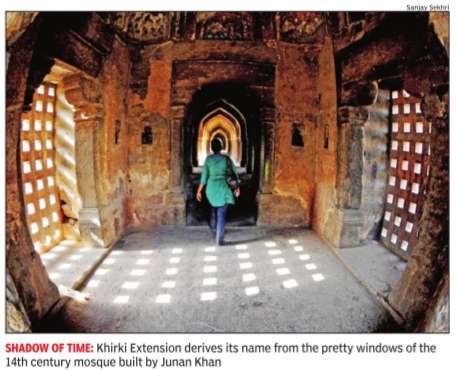Delhi: Trivia

This is a collection of articles archived for the excellence of their content. |
History: Stories behind naming some famous places in Delhi
The Times of India, Jul 22 2015
Joeanna Rebello
And did Khirki village have anything to do with windows? Which gruesome story lay behind Khooni Darwaza? City historian RV Smith talks about how Delhi named its gallis and chowks Most know the palimpsestic per sonality of this city of cities -a complex of seven mega settlements, the oldest of which is the putative Pandava's Indraprastha. Their very names -Shahjahanabad, Mehrauli, Lutyens' Delhi -summon a chapter in history . But the footnotes in these chapters are often written in the names of the minor markets, chowks and gallis that find their etymology in quirky historical personalities, legends and bizarre incidents that may or may have occurred there in the past. Too insignificant to have their histories committed to paper, these stories become local folklore, and today it's hard to separate fact from conjecture.
Take Matiya Mahal in Chandni Chowk for one. The name itself throws up a clue. “Some say the name stuck from the time the Jama Masjid was being built in the mid-17th century , when dust from the sandstone flew around and settled everywhere,“ says RV Smith, Delhi's own chronicler. “But I suspect the name derives from one of Shah Jahan's wives, Matiya Begum.“
Smith's new book, Delhi: Unknown Tales of a City -a collection of his newspaper columns, sheds light on another such clue-concealing name: Kingsway Camp, now known as Guru Teg Bahadur Nagar. It was to receive King George V and Queen Mary for the royal Durbar of December 1911 that a `city' of tents was erected to the north of the city . As many as 233 camps were spread out over 25 square miles, Smith writes, and it was down this sea of canvas that the royal couple rode towards their double-ringed durbar. It was also here that the gamechanging news of the relocation of the British capital from Calcutta to Delhi was publicly announced.
Names like Imamwali Galli, Machliwalan, Urdu Bazaar and Galli Kababian say it like it is -or was. But what secrets does a name like Ballimaran, home of Ghalib, conceal? “It was where boatmen on the Yamuna once lived, when traffic flowed on that river, and it was the `balli', the oar, that gave the area its name,“ says Smith, add ing that he's sometimes asked, somewhat ludicrously , if cats were slaughtered here.(Billimaran is how some hear it).
Some names are pretty easy to decipher. Jhandewalan, in central Delhi, is named for the holy pennants that flagged the place. You don't have to dig too deep to discover that Lal Kuan and Dhaula Kuan were named for the red sand and white sand at bottom of the respective wells in these areas, like Panchkuian was named for its five wells. Chandni Chowk was believed to have earned its nomenclature from the moon-reflecting pool of water situated smack in the middle of the bazar's square layout, designed by Shah Jahan's daughter, Princess Jahanara. Or it could be named after the silver shops that dominated the market.
Place names -these days the preserve of politicians and corporations -were once markers of overlords, saints and their stand-out monuments. Barakhamba Road, for example, is derived from the 14th century 12-pillared tomb of a nobleman.Khirki Extension owes its nomenclature to the khirkis or windows of the 14th century mosque built by Junan Khan, prime minister of Firoze Shah Tughlaq.
Khooni Darwaza, on Bahadur Shah Zafar Marg, has a gory backstory . It was at this gate -one of Afghan Sher Shah Suri's three Lal Darwazas -that Bahadur Shah Zafar's two sons and grandson were shot by the British in 1857. However, Smith got wind of another story, namely that it was here that criminals would be hanged till death here. There is also the theory that it was where Dara Shikoh's head was thrown to be devoured by wolves, after he was executed by his younger brother Aurangzeb.